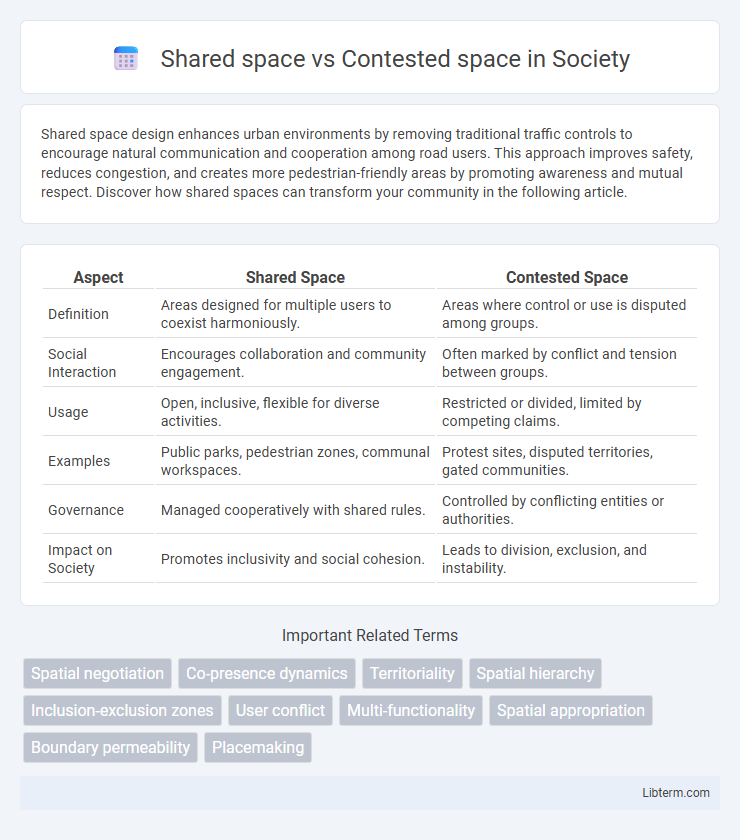Shared space design enhances urban environments by removing traditional traffic controls to encourage natural communication and cooperation among road users. This approach improves safety, reduces congestion, and creates more pedestrian-friendly areas by promoting awareness and mutual respect. Discover how shared spaces can transform your community in the following article.
Table of Comparison
| Aspect | Shared Space | Contested Space |
|---|---|---|
| Definition | Areas designed for multiple users to coexist harmoniously. | Areas where control or use is disputed among groups. |
| Social Interaction | Encourages collaboration and community engagement. | Often marked by conflict and tension between groups. |
| Usage | Open, inclusive, flexible for diverse activities. | Restricted or divided, limited by competing claims. |
| Examples | Public parks, pedestrian zones, communal workspaces. | Protest sites, disputed territories, gated communities. |
| Governance | Managed cooperatively with shared rules. | Controlled by conflicting entities or authorities. |
| Impact on Society | Promotes inclusivity and social cohesion. | Leads to division, exclusion, and instability. |
Introduction to Shared and Contested Spaces
Shared spaces encourage collaborative use by multiple groups or activities without strict boundaries, promoting coexistence and dynamic interaction. Contested spaces involve competing claims or conflicts over access, control, or meaning, often reflecting underlying social, political, or cultural tensions. Understanding the distinctions between shared and contested spaces is essential for effective urban planning, conflict resolution, and community development.
Defining Shared Space: Key Characteristics
Shared space is an urban design concept that removes traditional traffic controls to create an environment where pedestrians, cyclists, and vehicles coexist with equal priority. Key characteristics include the absence of traffic signals, the use of subtle visual cues such as road surface textures and street furniture to encourage natural negotiation, and an emphasis on human interaction to enhance safety and social connection. This design fosters slower vehicle speeds and increased awareness among users, promoting a more flexible and inclusive use of public space.
Understanding Contested Space: Core Concepts
Contested space refers to physical or symbolic areas where different groups assert competing claims, often leading to conflict over control, access, or meaning. Key concepts include power dynamics, territoriality, and social identity, which shape how actors interact within these spaces. Understanding contested space requires analyzing the underlying socio-political tensions and the strategies employed by stakeholders to negotiate or enforce dominance.
Historical Perspectives on Spatial Dynamics
Historical perspectives on shared space versus contested space reveal how urban environments often reflect power dynamics and cultural conflicts over territory. Archaeological findings and ancient city layouts demonstrate how shared spaces facilitated trade and social interaction, while contested spaces frequently arose from territorial disputes and colonial expansion. These spatial dynamics have shaped political boundaries and social hierarchies, influencing modern urban planning and conflict resolution strategies worldwide.
Social Impacts of Shared Spaces
Shared spaces promote social inclusion by encouraging interaction among diverse community members, reducing social barriers and fostering a sense of belonging. Studies show that shared spaces increase pedestrian activity and spontaneous social encounters, contributing to improved mental well-being and community cohesion. The design of shared spaces prioritizes accessibility and safety, which enhances trust and reduces social isolation in urban environments.
Conflicts and Challenges in Contested Spaces
Contested spaces often experience heightened conflicts due to overlapping claims from different social, ethnic, or political groups leading to disputes over resources, territory, and authority. These conflicts result in challenges such as increased violence, insecurity, disrupted social cohesion, and impediments to economic development or governance. Effective conflict resolution and inclusive dialogue remain essential to managing tensions and fostering stability in contested environments.
Urban Design Approaches: Shared vs. Contested
Urban design approaches to shared space emphasize the integration of pedestrian, cyclist, and vehicular traffic through minimal signage and physical barriers, promoting equality and interaction within public realms. Contested space strategies often rely on clear demarcation and regulation to manage competing uses, prioritizing safety and order by segregating activities. The choice between shared and contested space influences urban flow, social behavior, and safety outcomes, shaping how communities experience public environments.
Case Studies: Examples Around the World
Case studies of shared space and contested space reveal diverse urban approaches to public realm design, like the successful transformation of Exhibition Road in London into a shared space promoting pedestrian safety and social interaction. Contrastingly, contested spaces such as Taksim Square in Istanbul highlight ongoing conflicts over political symbolism and urban usage rights. These examples underscore the impact of spatial design on community identity and social dynamics globally.
Benefits and Drawbacks of Each Spatial Model
Shared space designs promote pedestrian safety and traffic calming by reducing traditional barriers like signs and signals, encouraging eye contact and natural negotiation between users; however, they can cause confusion and discomfort for vulnerable groups such as the elderly or disabled. Contested space, characterized by ambiguous boundaries and mixed-use areas, fosters social interaction and flexible use but often leads to conflicts and inefficient movement due to overlapping claims by different user groups. Evaluating local context and user needs is critical when balancing the benefits of enhanced social cohesion in shared spaces against the potential chaos and conflict inherent in contested environments.
Future Trends and Recommendations
Future trends in shared and contested spaces indicate a growing emphasis on adaptive design and technology integration to balance collaborative use and conflict mitigation. Smart sensors and AI-driven monitoring systems enhance real-time management, fostering safer and more inclusive environments. Urban planners should prioritize flexible infrastructure and community engagement strategies to anticipate evolving social dynamics and reduce spatial disputes.
Shared space Infographic

 libterm.com
libterm.com